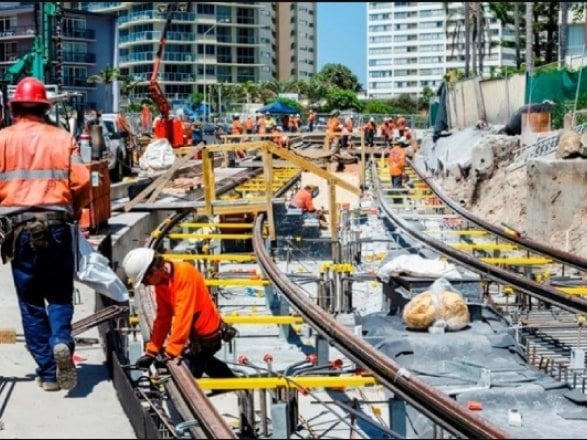Gold Coast Infrastructure and Utilities Projects
Bennett and Bennett has provided land surveying, town planning and spatial services throughout Southeast Queensland for more than 50 years.

With over 100 employees, the company is well resourced for small and large-scale projects and has adapted its business over time to embrace the latest technology and surveying methods.
Most recently, Bennett and Bennett introduced wireless condition monitoring technology to provide real-time data to clients on all manner of infrastructure, construction and utilities projects.
Working with intelligent solutions provider Position Partners, the company first adopted the Senceive wireless monitoring system, which utilises a range of sensors or nodes that are connected wirelessly to a solar-powered gateway. The gateway relays monitoring information in real-time to a web-based reporting platform, giving customers highly accurate data 24 hours a day.
Measurement of Track Tilt on Light Rail
The team first used the Senceive system on the Gold Coast light rail project, where they measured changes in rail track tilt and provided as-built surveys.
Chris Swane, Company Director, said:
“We learnt a great deal on that project about the system and its capabilities.”
Optical Displacement and Tilt Sensors Used on Reservoir
Chris Swane said:
“On the next project at Sparkes Hill reservoir in Brisbane’s north, we upskilled further and added optical displacement sensors in addition to the tilt sensors.”
As with any new technology, it was important to get the upskilling and on-boarding process right.
Mr Swane said:
“The support and advisory capacity of the local Position Partners team in Brisbane has been excellent. They provided a great deal of advice about the systems and helped us understand the different options and suitability, which changes over time as new technology becomes available. We also relied on them for training and getting the systems configured. I can’t fault Position Partners on the assistance and support they provided.”
Wireless Systems Compared to Traditional Surveying Techniques
Prior to introducing the Senceive wireless monitoring platform, Bennett and Bennett used traditional surveying techniques to monitor movement in structures.
Mr Swane said:
“On a historic building, for example, we would have relied on angular measurement – reading multiple angles to a wall and setting up brackets at the top and bottom of the structure so that we could measure for any movement. Those methods take a lot of time, you have to be on site to take the readings, whereas the Senceive system operates around the clock once it’s setup. Then of course there’s the cost to factor in; not having a surveyor on site taking measurements at the standard charge out rate makes it much more cost-effective for our clients to have the wireless monitoring systems installed on their sites.”
Mr Swane said that in addition to the constant data feeds and cost savings from wireless monitoring technology, the ability to configure alerts for different parameters of movement or vibration is also well received by clients.
Mr Swane said:
“There’s definitely some education involved to explain what these alerts really mean and relate them back to the millimetres of movement they relate to. But the good thing about these systems is that you can set different levels of alerts that perhaps go to different stakeholders. For example, a low-level alert might go to the consultant and the surveyor as a forewarning, but a more critical alert level might go to the client and perhaps the builder on site, so if they hear it go off they know to stop work immediately.”
Another benefit Mr Swane cites is that condition monitoring technology delivers a greater level of traceability.
Mr Swane said:
“Clients can compare any potential movement from the start of the year to the end of the year, or with vibration they can analyse trends in activity over time.”
Structural Monitoring During Excavation Works
A high-rise tower in Brisbane’s CBD was monitored for movement as well as vibration during excavation work for the Albert Street Tunnel, part of the city’s new Cross River Rail project. Bennett and Bennett used Senceive’s wireless FlatMesh™ monitoring system and a combination of both tilt and optical displacement sensors to measure for the slightest movements in the tower, with live data available around the clock to the Bennett and Bennett team and other project and building stakeholders.
Bennett and Bennett also utilised standard digital levelling techniques to monitor subsidence on the tower, as well as a Vernier micrometer for measuring cracks.
Mr Swane said:
“We were keen to try out Senceive’s crack monitoring technology, however the real-time, 24/7 data it provides wasn’t required on this project as we only needed to record measurements every six months.”
Live Subsidence Monitoring Critical for Wastewater Treatment Plant
At the Elanora wastewater treatment plant on the Gold Coast, Bennett and Bennett was hired to monitor subsidence and movement of the building as it was underpinned over a 3-month period.
The Bennett and Bennett team deployed a combination of Senceive’s tilt and optical sensors to monitor the movement of the walls as they underpinned the building.
Mr Swane said:
“The client wanted real-time reporting on the movement while they were doing the work to determine if what they were doing was causing movement, which it was. Like we did for the high-rise tower, alerts were put in place for the Elanora stakeholders that were sent to their mobile, tablet or desktop computer if movement occurred that was outside the tolerance levels. With the Senceive system we were able to graph the results over the three month period and demonstrate that there was some movement at certain times when the work was taking place, and that it stabilised after the work.”
www.senceive.com

